Pennsylvania's youngest Interstate itself has a longer history than it has had its designation. It was once part of the major Interstate 95 corridor running along the Eastern Seaboard, which connects some of the largest cities in the United States.
The first section to be built which would encompass part of what would eventually become Interstate 295 was the Scudder Falls Bridge. Plans for a new bridge were conceived following the destruction of the Yardley-Wilburtha Bridge, roughly a mile south of the new bridge, during flooding caused by Hurricanes Connie and Diane in August 1955. The location of the new bridge was approved with little opposition in April 1958. Since it was not originally part of the Interstate Highway System, the federal government paid 50% of the construction costs, with the Delaware River Joint Toll Bridge Commission overseeing construction and Pennsylvania and New Jersey paying the other half. This was the reason that it was not a toll bridge outright, but rather just a toll-supported DRJTBC bridge.
Work began on the 1,740-foot-long crossing on August 8, 1958, and while the $2,286,610.40 span was completed in October 1960, it did not open to traffic until June 22, 1961, due to incomplete approaches on both sides of the Delaware River. The ribbon was cut by John M. Scudder, who represented the seventh generation born on the family property, which was taken for the approach on the New Jersey side of the river. The ceremony also featured a vehicle caravan as well as speeches by Pennsylvania Secretary of Highways Park H. Martin and Dwight R. G. Palmer, New Jersey's Highway Commissioner.
Originally, Pennsylvania wanted to route Interstate 95 along the US 13 corridor, leaving its current alignment at Exit 39. New Jersey did not like this routing on the basis that it would overtax the four-lane Trenton Toll Bridge and Trenton Freeway. The states studied three alternatives for a crossing: Scudder Falls west of Trenton, the existing Trenton Toll Bridge, and Biles Island to the east of Trenton. The two states approved the Scudder Falls crossing in 1960 and the Bureau of Public Roads approved the new alignment of Interstate 95 in 1964. This is why a direct connection between the Pennsylvania Turnpike and the Interstate was not constructed at that time.
Construction did not begin on the first section until 1968 when work began from US 1 to the New Hope interchange and the approach to the Scudder Falls Bridge. A year later, work would begin on the part from the current Interstate 95/Pennsylvania Turnpike interchange to Old Lincoln Highway, which is now designated as Business US 1.
The 1970s started off with the expressway opening between US 1 and the Scudder Falls Bridge in 1970 while construction began between Business US 1 and US 1 that year. In 1973, the section between the current Interstate 95/Pennsylvania Turnpike interchange and US 1 opened to traffic, thus completing what would eventually become Interstate 295.
By the late 20th Century, the Delaware River Joint Toll Bridge Commission conducted two studies focusing on improving conditions on and approaching the Scudder Falls Bridge: the Traffic Study of Trenton-Morrisville Bridge Crossings over the Delaware River in 1990 and the Southerly Crossings Study in the early 2000s. The latter study showed that in 2002 the bridge was being used by 55,000 vehicles a day, much more than the 40,000 it was designed to carry. It estimated that by 2030, traffic would increase by 35% or the equivalent of 19,000 more vehicles. The 2002 study also indicated that the bridge was given a Level of Service (LOS) grade of "F" during peak rush hours and afternoons, which denotes the worst service conditions and the highest congestion rate. Even though routine inspections never revealed any serious structural problems, the condition of the bridge was becoming a growing concern. It was of a similar design to that of the Mianus River Bridge on Interstate 95 in Greenwich, Connecticut, which suffered a fatal collapse in 1983.
The Delaware River Joint Toll Bridge Commission entered into a Memorandum of Agreement in 2002 with the Pennsylvania Secretary of Transportation and the New Jersey Commissioner of Transportation to proceed with environmental studies and preliminary design for a new span. Open houses by the DRJTBC took place on both sides of the Delaware River in June 2004 to show the public proposed improvements. The plans all included provisions for three through lanes in each direction, as well as a lane for traffic entering and exiting at the interchanges at either end of the bridge. The four concepts proposed were:
- Widening the existing bridge.
- Constructing a new bridge on either side of the existing bridge essentially doubling capacity.
- Constructing collector-distributor roadways on either side of the exiting bridge for local traffic while retaining the existing bridge for through traffic.
- Widening the Interstate on the Pennsylvania side from four to six lanes, either by adding the additional lane in the median or the outside of the existing roadway, from the PA 332 interchange to the bridge.
The preferred option was chosen in early 2005 and the environmental impact studies were conducted and completed a year later. Originally, construction was planned to begin in 2008 and finish two years later.
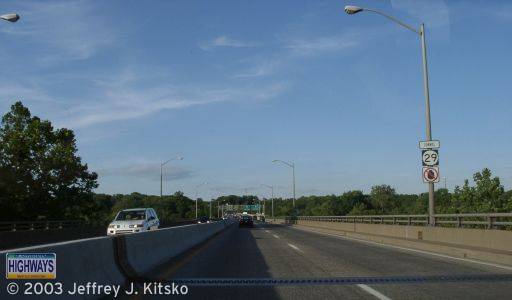 |
| The former Scudder Falls Bridge on the northbound side as it appeared in 2003. |
At a meeting held on December 21, 2009, the Delaware River Joint Toll Bridge Commission decided to make the new Scudder Falls Bridge a toll bridge unlike its predecessor. The Commission felt that it was unfair for users of their other toll bridges to have to pay for one they do not use, and it would help to mitigate system-wide toll increases that would otherwise be needed to pay for the replacement, which was the largest single construction project in its history. All work involving a new span would total around $310 million with the Commission paying 50% and PennDOT and NJDOT each chipping in 25% much like how costs were split for the original bridge.
The project took another step closer to fruition on June 14, 2012, when the Federal Highway Administration issued its Finding of No Significant Impact (FONSI) report. In it, the FHWA stated that the Proposed Action included all practicable measures to minimize harm to natural, cultural, and socioeconomic resources, which may result from the project. With this news, preparations moved to updating project right-of-way plans, identification and execution of priority items in anticipation of design and construction, and delivery of unearthed archaeological materials to the state museums in Harrisburg and Trenton. The project moved into the final design phase in early 2015 after the completion of a system-wide traffic and revenue study in 2014. By the time the of the latter stages of the final design process in 2016, the project cost had risen to $439 million.
Initial work began in early 2017 with construction of noise walls at points along the Interstate through Lower Makefield Township. Construction began on the bridge in the summer of 2017 which entailed building a new span consisting of three through lanes and one auxiliary lane immediately upstream of the former bridge; reconstructing the NJ 29 interchange at the northern end of the bridge; reconfiguring the Taylorsville Road interchange at the southern end; widening the approach on the Pennsylvania side; installation of an all-electronic tolling (AET) gantry with E-ZPass transponder readers, high-resolution cameras, and associated infrastructure for high-speed toll collection; and construction of a shared-use pedestrian/bicycle path. The new upstream span opened July 9, 2019, with all traffic shifting to it separated by a temporary barrier separating the opposing directions of travel so that demolition could begin on the old bridge. Toll collection began July 14, 2019, for Pennsylvania-bound vehicles, which made the Scudder Falls Toll Bridge the first Delaware River Joint Toll Bridge Commission toll bridge to be completely cashless.
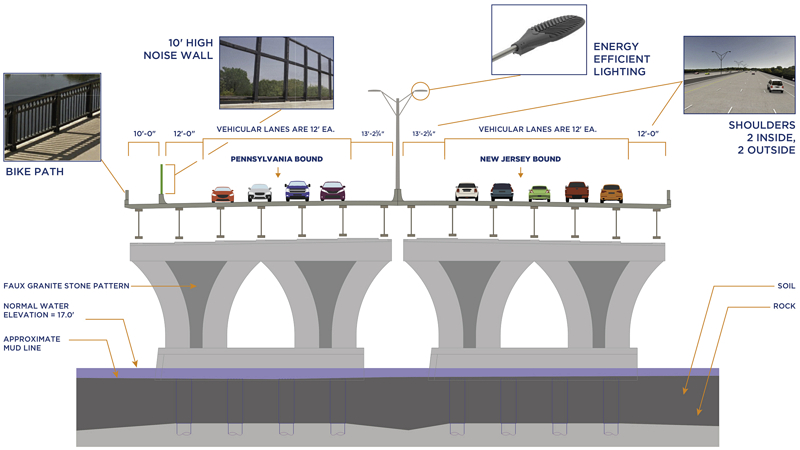 |
| Cross-section of the Scudder Falls Toll Bridge's final configuration. (Delaware River Joint Toll Bridge Commission) |
Demolition on the old Scudder Falls Bridge as well as construction on the new downstream span with three through lanes and two auxiliary lanes began in the summer of 2019. Construction also began on completing the reconfiguring of the Taylorsville Road and NJ 29 interchanges on either side of the bridge, improving drainage at the NJ 29 interchange, and completing access to the shared-use pedestrian/bicycle path from both states. Work on the latter was completed in the fall of 2021, which is the only facility of its type across the Delaware River between Pennsylvania and New Jersey and permits cyclists to cross without having to dismount. It also restores pedestrian and bicycle access to cross the river in the Yardley area, which had been unavailable since the 1955 destruction of the Yardley-Wilburtha Bridge.
The New Jersey-bound span opened to traffic on August 17, 2021. Both spans include 12-foot outer shoulders in case of breakdowns or emergencies and 13-foot inner shoulders built wide enough to handle possible future use as bus lanes. On the night of December 15, 2021, after four and one-half years of construction, the $534 million project reached the "substantial completion" milestone, which meant all long-term uninterrupted lane and ramp closures had concluded for the project. Only short-term restrictions were required to finish remaining project tasks moving forward.
| History of the Scudder Falls Bridge replacement project. (Delaware River Joint Toll Bridge Commission) |
It seems that construction has been the order of the day for both ends of Interstate 295 in the Commonwealth during its infancy. While the replacement of the Scudder Falls Bridge has been going on at the eastern entrance, the project at the western terminus has been a long time in coming.
As mentioned above, Interstate 95 was planned to follow US 13 past the Turnpike, which would have provided a direct connection between the two roadways. Beside the noted objections from New Jersey, the Interstate could not be built north of the Turnpike along US 13 due to it possible negative environmental impacts. The United States Congress passed the 1982 Surface Transportation Assistance Act (STAA), which mandated the completion of Interstate 95 using the existing Pennsylvania and New Jersey turnpikes. Act 61 passed in 1985 by the Pennsylvania legislature authorized the Pennsylvania Turnpike Commission to complete projects PennDOT could not as well as initiate improvements to the Turnpike System, which included building an interchange between Interstate 95 and the Pennsylvania Turnpike. The first interchange design studied between 1984 and 1988 was to be a simple trumpet-to-trumpet connector, which engineers concluded would be inadequate for the amount of traffic that would flow between the two roadways. Another plan devised was to extend the PA 413 interchange beyond that route and connect to the Turnpike; however, that plan would have taken 150 homes and cut through Delhaas Woods. Even though by 1999 that plan had changed to require only taking 10 homes and sparing the park area entirely, it was rejected as a viable option. The Federal Highway Administration issued its Record of Decision on December 31, 2003, which chose Project Alternative 1 as the project to move forward due to the limited impacts on the environment as well as to structures with the Single Loop A interchange design picked for the junction of the Turnpike and Interstate 95.
On January 6, 2004, the US Department of Transportation approved the environmental impact study. "Late 2007" was the "optimistic forecast" for groundbreaking for Stage 1, said PTC spokeswoman Christina Hampton after the announcement was made. That stage involved building the high-speed interchange, a new toll plaza on Interstate 276, and widening the Turnpike from Exit 351 to the Delaware River, with Stage 2 involving constructing a parallel span across the Delaware River south of the exiting bridge. Preliminary design took place from 2004 until 2008, with final design taking place from 2009 until 2010.
"Late 2007" did turn out to be an optimistic forecast for groundbreaking, because it would six years later when PTC CEO Mark Compton joined Governor Tom Corbett and Lieutenant Governor Cawley as well as federal, state, and local officials at the Turnpike's former Trevose Maintenance Facility, where the mainline toll plaza was built, in Bensalem on July 30, 2013, to officially kick off the start of the $500 million Stage 1 of the project. "We’re here to commemorate the beginning of a critical infrastructure project that will undoubtedly improve the quality of life for residents and commuters in the surrounding area," said Turnpike Chief Executive Officer Mark Compton. "Many also consider the Turnpike/I-95 link to be a central component for the continued economic growth and competitiveness of this region." Although work had already been taking place, this ceremony marked the official start of the main project.
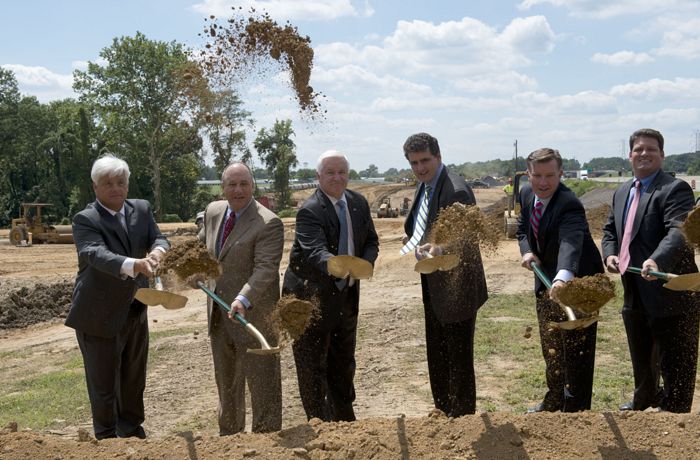 |
| Governor Tom Corbett is joined by local and state officials at the official groundbreaking for the Interstate 95/Turnpike interchange. (Pennsylvania Commonwealth Media Services) |
An unusual financing scheme to complete the interchange came to light in April 2013, just before the groundbreaking. Foreign investors, primarily from China, would infuse the project with $200 million, and in turn, they would get green cards for themselves and their families. The deal involves creating a new limited partnership called the Delaware Valley Regional Center Pennsylvania Turnpike L.P., with an office in Berwyn, that would have to be approved as a US Citizenship and Immigration Service designated "regional center" to recruit foreign investors with which to provide the Turnpike Commission the loan. On April 26, the PTC signed a $200 million loan agreement with the limited partnership. Federal law permits the dealmakers to go immediately to China, or elsewhere, to begin recruiting investors, but they can not accept funds until approval. Despite some success around the country with these type of partnerships, the Immigrant Investor Program has drawn criticism for lax oversight and dubious projects that have not produced domestic jobs nor permanent green cards for foreign investors.
With the impending opening of the first set of ramps at the interchange which would make Interstate 95 a continuous route, work began on redesignating the former route through Bucks County. Initially, the plan was to extend the Interstate 195 designation from its terminus at Interstate 295 across the Delaware River in New Jersey around Trenton and make the new interchange its new western terminus. However, the layout of the Interstate 195/Interstate 295 made the latter route a more congruent alignment through that junction, so it was instead extended past the US 1 interchange north of Trenton and into Pennsylvania. Unlike Interstate 95 which was marked as a north-south route, Interstate 295 would be an east-west route in Pennsylvania. The Delaware River Joint Toll Bridge Commission took care of swapping out the route and directional markers as well as the exit numbers for the Taylorsville Road interchange in March 2018, with the Pennsylvania Turnpike Commission handling that project from the future interchange to the Taylorsville Road interchange, which was completed in July 2018.
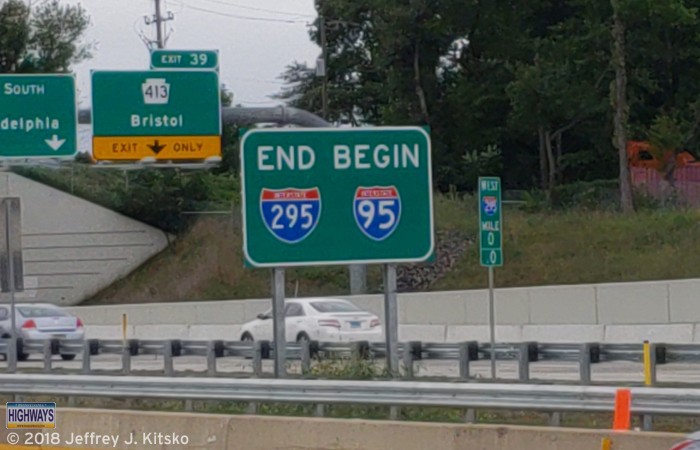 |
| Mile marker 0 and a sign denoting the end of Interstate 295 at its western terminus at Interstate 95 and the Pennsylvania Turnpike. |
Work on the first stage concluded on September 21, 2018, with a ribbon cutting ceremony at the Bristol Plaza shopping center near the new interchange. The new ramps between Interstate 95 northbound and the Turnpike eastbound as well as the Turnpike westbound to Interstate 95 southbound opened to traffic on September 24, 2018 which marked the first time drivers utilizing Interstate 95 between New York and Philadelphia could do so unimpeded. On that day, the Interstate 95 designation was officially changed to follow the Turnpike over the Delaware River Bridge, and the original route north of the Turnpike became Interstate 295. The remaining ramps which will provide movement between Interstate 295 and the Turnpike will be built once funding is secured.
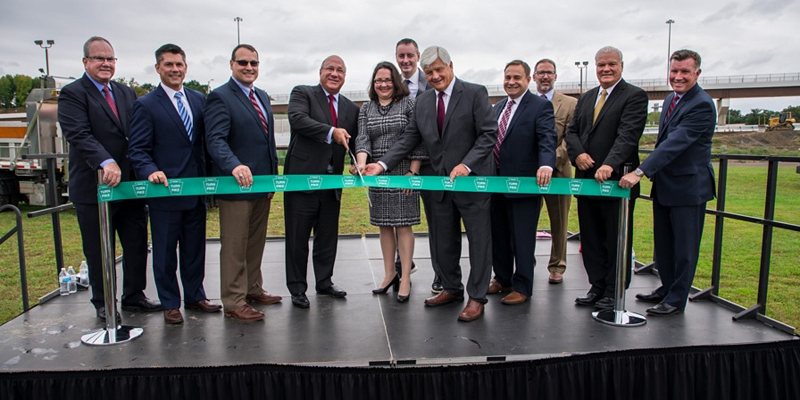 |
| State and local officials at the ribbon cutting ceremony on September 21, 2018. (Pennsylvania Turnpike Commission) |
The over $260 million project was recognized by the Construction Management Association of America's Mid-Atlantic chapter as its Project of the Year for 2018. At the chapter's awards banquet held in Philadelphia in July 2019, the award in the "Mega Project over $100 million" category was presented to Urban Engineers. "We would like to congratulate the Turnpike Commission, PennDOT, and the firms involved in the successful completion of this dynamic interchange project," said Jerry O’Neill, PE, CCM, senior vice president and general manager for transportation construction services at Urban Engineers. "This is an important project for Southeast Pennsylvania that will provide more efficient travel for motorists, less congestion to surrounding communities, and growth in the region. We are very proud of our construction management staff who have spent many years working diligently on this project."
|
| Western Terminus: | I-95 and I-276 in Newportville |
| Eastern Entrance: | New Jersey state line at the Scudder Falls Toll Bridge in Yardley |
| Length: | 10.86 miles |
| National Highway System: | Entire length |
| Names: | Vietnam Veterans Memorial Highway Delaware Expressway |
| SR Designation: | 0295 |
| County: | Bucks |
| Multiplexed Routes: | None |
| Former Designation: | I-95 (1964 - 2018) |
| Former LR Designations: | 1000 I-95 and I-276 to Exit 10 1020: Exit 10 to the New Jersey state line |
| Emergency: | 911 |
| Advisory Radio: | None |
| Links: | Exit Guide Interstate 295 Ends Interstate 295 Pictures E-ZPass - Delaware River Joint Toll Bridge Commission I-95 Link I-95/I-295 Signing Redesignation - Delaware River Joint Toll Bridge Commission PA Turnpike/I-95 Interchange Project - Pennsylvania Turnpike Commission> Scudder Falls Bridge Replacement Project - Delaware River Joint Toll Bridge Commission Scudder Falls Bridge Replacement Project - Delaware River Joint Toll Bridge Commission Scudder Falls Toll Bridge - Delaware River Joint Toll Bridge Commission Interstate 295 - Andy Field/Alex Nitzman Interstate 295 - David Golub Interstate 295 - Scott Oglesby Interstate 295 - Delaware Valley - Andy Field/Alex Nitzman Interstate 295 Photos - Valerie Deane Scudder Falls Bridge (I-95) - Steve Anderson |
 Vietnam Veterans Memorial Highway
Vietnam Veterans Memorial Highway INFORMATION
INFORMATION